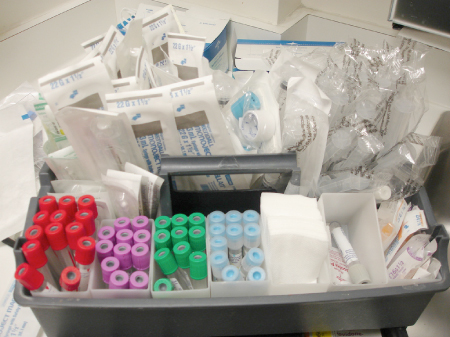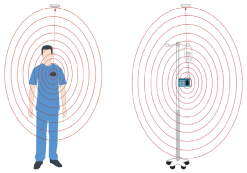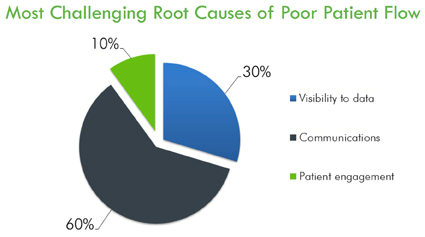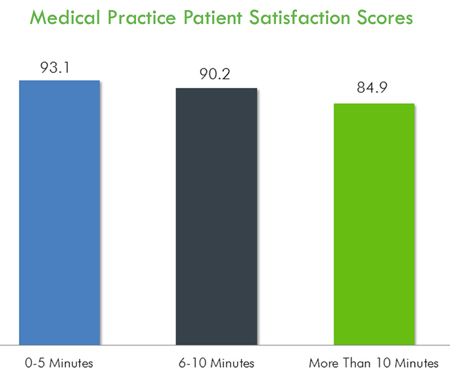A study explaining how the use of RTLS systems for tracking in hospitals can improve the patient experience and operational efficiency, impacting patient satisfaction
by Susan Pouzar, Versus Technology
 Recent federal healthcare reforms call for higher quality, safer patient care delivered with improved customer service. At the same time, declining reimbursements threaten clinic profitably and fuel the need to see more patients in less time. Caught in the middle are medical practice managers, physicians and nurses struggling to realize the promised efficiencies of electronic health records (EHRs) while maintaining high levels of care. As a result, clinics are searching out technology that can improve efficiency and the patient experience. One innovation that addresses both challenges is the use of Real-time Locating Systems (RTLS). An accurate RTLS can help practice managers and providers understand patient progression and staff workflows, and eliminate wasted time.
Recent federal healthcare reforms call for higher quality, safer patient care delivered with improved customer service. At the same time, declining reimbursements threaten clinic profitably and fuel the need to see more patients in less time. Caught in the middle are medical practice managers, physicians and nurses struggling to realize the promised efficiencies of electronic health records (EHRs) while maintaining high levels of care. As a result, clinics are searching out technology that can improve efficiency and the patient experience. One innovation that addresses both challenges is the use of Real-time Locating Systems (RTLS). An accurate RTLS can help practice managers and providers understand patient progression and staff workflows, and eliminate wasted time.
Just what is a real-time locating system? Think of RTLS as GPS for the indoors—a system that displays the real-time locations of people and things on a map (or in a list). Different RTLS solutions use different technologies to determine locations, but they all work in the same general way. Badges worn by people, and tags affixed to equipment, communicate with a sensory network of receivers installed throughout a facility (Figure 1).
The sensory network (Figure 2) relays the location of badges and tags to software. Depending on the accuracy of the RTLS and the density of receivers, the reported location can either be general (‘1st Floor’ or ‘West Wing’), or precise (‘Exam Room 8’ or ‘Infusion Chair 2’).
Real-time snapshot
This real-time snapshot of locations is displayed on workstations, mobile devices and overhead displays, for example in a list or on a map of the facility. The location information provides immediate and real-time operational visibility to all staff. Hospitals were early adopters of RTLS in the 1990s, and continue to use the technology to locate high-value assets and mission-critical devices, as well as to locate patients and personnel. Beyond basic locating applications, hospitals also use RTLS to ensure patient safety, document caregiver-to-patient interactions, and—most applicable to medical clinics—track patient flow for throughput management. There are seven ways in which RTLS can increases patient volume and improves satisfaction.
Expediting patient flow
According to the 2012 American Hospital Association assessment, the largest contributor to poor patient flow is communication. The second largest contributor is visibility to data (Figure 3). This is true not only in hospitals, but also in medical clinics and ambulatory surgery centers. RTLS addresses both of these challenges—in addition to maximizing the efficiency of EHR adoption. Clinic staff must ask and answer these questions for every patient:
- which exam room is available?
- where is the patient?
- how long has she been waiting?
- are her diagnostic tests complete?
- whose turn is it to see the patient?
Tracking down staff, placing phone calls or walking the halls to get answers wastes valuable time. Everything from patient rooming to room turnover is delayed. RTLS automatically communicates this need-to-know information by passively tracking and displaying patient status and staff location. Staff no longer have to call down the hall or place phone calls to find a patient or caregiver. Because the software notes who has already been with the patient, questions about what should happen next are answered quickly and efficiently.
While technology can never entirely replace the need for face-to-face or phone conversations, it can facilitate them. RTLS allows staff to easily locate one another when direct communication is needed. Time previously wasted tracking down staff is eliminated when a doctor knows what room her medical assistant is in or what extension to ring for the nurse.
Visibility of data
 A 2011 survey conducted by the Medical Group Management Association found that practices designated as ‘better performers’ were more likely to say they paid close attention to patient flow. So how does a practice pay close attention? It all hinges on data about patient visits:
A 2011 survey conducted by the Medical Group Management Association found that practices designated as ‘better performers’ were more likely to say they paid close attention to patient flow. So how does a practice pay close attention? It all hinges on data about patient visits:
- how long do patients sit in the waiting room?
- how long do patients wait in the exam room?
- what is the average ‘door-to-doctor’ time?
- what is the average overall length of stay?
- if we change a process, what impact does it have on throughput?
To obtain this data, patient flow experts often advise performing time studies to determine how long it takes patients to move through a practice. While manual time studies can produce useful insights, they can be time-consuming, costly and difficult to perform on a regular basis. With RTLS, a time study is automatically conducted at all times, behind the scenes, by passively monitoring the locations and interactions of patients and staff. A practice manager can run reports on average patient care milestones such as wait time, ‘door-to-doctor’ time, exam duration, overall length of stay, for any given time frame. This data can be broken down by patient type, provider, or any number of variables, offering a previously unattainable level of business intelligence.
 The data can be used to identify bottlenecks and tweak processes. And, because the RTLS continually monitors these milestones, improvement can be definitively measured. EHRs will always require some level of data entry—the key to optimizing the EHR is to automate every data point possible so that skilled, highly-paid staff are not doing tedious, non-patient-centric documentation. RTLS enables such optimization by making EHRs, practice management systems and scheduling systems location-enabled. That is, the RTLS integrates with these systems, allowing patient location and patient-staff interactions to link with the patient record, eliminating routine data entry.
The data can be used to identify bottlenecks and tweak processes. And, because the RTLS continually monitors these milestones, improvement can be definitively measured. EHRs will always require some level of data entry—the key to optimizing the EHR is to automate every data point possible so that skilled, highly-paid staff are not doing tedious, non-patient-centric documentation. RTLS enables such optimization by making EHRs, practice management systems and scheduling systems location-enabled. That is, the RTLS integrates with these systems, allowing patient location and patient-staff interactions to link with the patient record, eliminating routine data entry.
Eliminating wasted time
The concept of ‘lean management’ or ‘lean thinking’ is increasingly and successfully being applied in healthcare, with a goal of driving out waste so all work serves the customer’s (i.e. the patient’s) needs.
 One of the leaders of lean thinking in healthcare, Virginia Mason Medical Center, uses RTLS to support lean methodologies at its Kirkland Clinic. Of particular concern was the practice of ‘batching’ indirect patient care. Waiting until the end of a day to do all indirect care at once not only caused doctors to stay late, it also presented the medical assistants (MAs) with a ‘huge batch’ to process in the morning. This prevented the MAs from focusing on the current day’s patient care, and they began every day already behind. Virginia Mason uses RTLS to directly address the batching problem. Thanks to more efficient patient flow and the operational visibility RTLS offers, doctors and MAs are now able to identify periods of time between patients when they can perform 5-10 minutes of indirect care, such as patient documentation review of patients’ labs or tests.
One of the leaders of lean thinking in healthcare, Virginia Mason Medical Center, uses RTLS to support lean methodologies at its Kirkland Clinic. Of particular concern was the practice of ‘batching’ indirect patient care. Waiting until the end of a day to do all indirect care at once not only caused doctors to stay late, it also presented the medical assistants (MAs) with a ‘huge batch’ to process in the morning. This prevented the MAs from focusing on the current day’s patient care, and they began every day already behind. Virginia Mason uses RTLS to directly address the batching problem. Thanks to more efficient patient flow and the operational visibility RTLS offers, doctors and MAs are now able to identify periods of time between patients when they can perform 5-10 minutes of indirect care, such as patient documentation review of patients’ labs or tests.
Reducing wait times
Whether it is at the grocery store, the Emergency Department, or in a physician’s office, nobody likes to wait. Long wait times negatively impact patient satisfaction (Figure 4), referrals, and ultimately revenue. RTLS proactively monitors patient wait times so staff can address issues as they arise, decreasing overall wait times and improving patient satisfaction.

RTLS software displays wait times for each patient on workstations or overhead LCD screens, and generates automatic visual cues or alerts should a patient’s wait time exceed a pre-established benchmark. The Dana-Farber Cancer Institute’s Yawkey Center for Cancer Care ensures patients never wait so long as to be forgotten. The RTLS automatically generates pop-up alerts and sends e-mails to caregivers when patients have exceeded 20-, 40-, or 60-minute wait times.
Using RTLS, Pacific Medical Centers’ Canyon Park Clinic significantly reduced the size of its waiting room, increasing usable (and revenue producing) space.1 The RTLS allows quicker rooming of patients and automatic notification to caregivers when their next patient is ready to be seen.
Thanks in part to the reduced wait times, Canyon Park, the first of Pacific Medical Centers’ clinics to implement RTLS, received the highest ‘excellent’ overall rating in the health system, 85 percent, during the first year in its new building—a time that is normally an adjustment period to new space and workflows. The clinic improved even more in its second year, earning a 91 percent ‘excellent’ rating overall.
Better communication
On days when longer wait times simply can’t be avoided, one method practices can use to maintain patient satisfaction is waiting room rounding. Practices can also use RTLS reports to ensure rounding was performed. During the patient visit, RTLS can help a provider focus on his patient, ensuring that he never has to leave the room to gather information or find missing equipment.
Further, RTLS is shown to improve communication with patients by giving staff more time. Because doctors, nurses and MAs no longer have to search for each other and equipment, and because they spend less time recording data now automated by RTLS, they are better able to promptly answer phone calls and e-mails from patients.
Improving room turnover
When a patient’s visit is complete, efficient flow and throughput depend on cleaning the room and readying it for the next patient as quickly as possible. How does staff know when a room is ready for turnover and which rooms are open for the next patient? If the answer is some form of manual communication, how often is that communication delayed or forgotten in a busy practice? RTLS enables faster turnaround as the process is immediate and automatic.
When a patient completes his visit, the badge is returned to reception and placed in a discharge cabinet. Sensing the badge there, the RTLS automatically and immediately changes the status of the patient’s exam room to ‘ready for cleaning’ and informs staff via visual cues on the electronic board or through alerts sent to mobile devices. When the room is clean, the RTLS changes the room status based on a staff person exiting the room or pressing a ‘room clean’ button on the wall. With a glance at the RTLS software, staff know which room(s) need cleaning and which are ready for patients .
